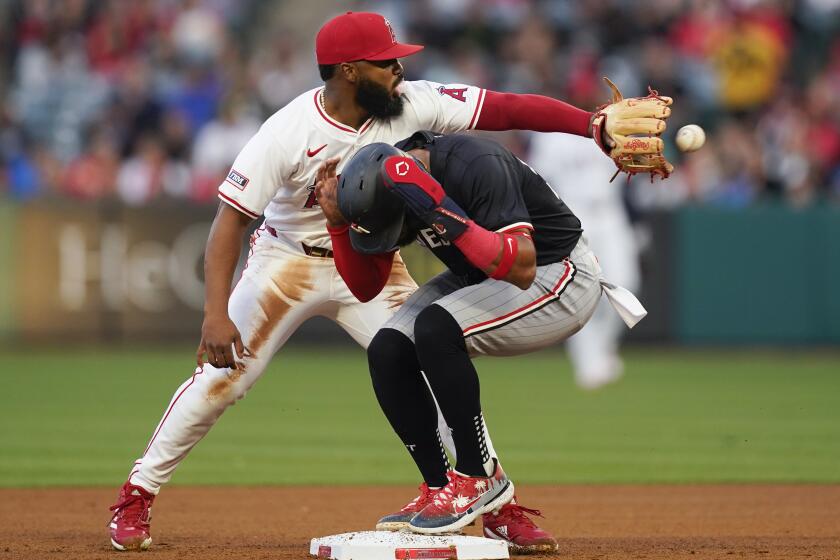From farm country and the Dodgers’ farm system, Jerry Sands makes the big leagues
This used to be tobacco country. Still is, but the demand for tobacco is down, the demand for soybeans and sweet potatoes is up, and the farmers have adjusted accordingly.
This is not a land of pretense. On the highway leading into town, a small green sign celebrates a hometown star.
The star is not Ava Gardner — the Hollywood glamour girl who was born nearby and was buried here, the legendary actress and onetime wife of Frank Sinatra. The star is a guy who made it to the major leagues and hit .230.
“Welcome to Smithfield,” the sign reads. “Hometown of Barry Foote, major league baseball player and coach.”
Smithfield also is the hometown of Jerry Sands, the rookie thrust into the Dodgers’ offensively challenged lineup ahead of his time. In his month in the major leagues, he has yet to hit a home run. He is batting .206.
Maybe he takes off soon. Maybe this is too much too soon — Sands was playing Class A ball this time last year — but a visit to his hometown helps reveal why the Dodgers believe Sands’ makeup is so strong he could handle success or failure in the major leagues at such a young age.
He is 23, barely older than the kids at his old high school, where he worked as a substitute teacher last winter.
“It was pretty easy,” Sands said. “You don’t have to work nights and weekends. It’s pretty much 8 to 3 every day, and I could make my own schedule. If I didn’t want to work, I would just say no.”
He said he taught “just about every subject,” using lesson plans left by the regular teachers. He even supervised detention.
“I guess they figured I could handle all the kids who ended up angry,” Sands said.
No wonder, said Mike Joyner, the high school baseball coach and athletic director.
“At 6-4 and 220, not a lot of people are going to question his authority,” Joyner said.
Sands would pack his workout bag too. He would teach his classes, then change clothes, lift weights and hit with the varsity baseball team. As part-time jobs go, that’s pretty sweet.
“And it’s not bad money,” Joyner said. “You get 80, 90 bucks a day.”
Minimum wage in the major leagues is $414,000 a year, but Sands says he’ll be back at his old high school this winter. He might not teach as often, but this is who he is, this school and this town.
His fiancée played on the high school softball team. His father was a heavy equipment mechanic.
“We had a bad roof on our dugout,” Joyner said. “The thing was about to fall in. Jerry and his dad put on a new one for us.”
The backyard of the family home spilled into a couple dozen acres of woods, perfect for summer campouts. Sands and his fiancée just bought a home of their own, a few miles away, neither wanting to move too far from the parents.
Sands had never traveled west of Tennessee until he signed with the Dodgers, not that he was embarrassed about that.
“I’ve never been a city type,” Sands said. “That down-home, out-in-the-middle-of-nowhere feel? I like it.”
If you put everyone in Smithfield into a seat at Dodger Stadium, you still would have 43,000 empty seats. In terms of attractions in Smithfield, well, Sands had a hard time coming up with any.
“To be honest with you, there’s not a whole lot to do,” he said. “It’s pretty much farming country.”
In 1865, Union Gen. William Tecumseh Sherman marched into Smithfield, where he stood on the courthouse steps to announce that Confederate Gen. Robert E. Lee had surrendered to Union Gen. Ulysses S. Grant at Appomattox.
“Band after band … made the little old town echo with music as beautiful as it was patriotic,” wrote one of Sherman’s officers.
The famous Smithfield hams are from Virginia, although the folks here think their hams taste better. Smithfield held its annual Ham and Yam Festival last weekend, and 4,000 hammers and yammers crammed into a performance by Night Ranger, the 1980s rock band.
“Four thousand people in one place in this town,” Joyner said, “is pretty crowded.”
Sands thought about it some more. Yes, he said, he could think of something to do in Smithfield.
“There’s the Ava Gardner Museum,” he said. “But it’s not very exciting.”
So we walked to the museum and asked the woman behind the counter whether everybody in town was excited about Sands making the major leagues.
“I don’t know about everybody,” she said.
And then she grinned. Her name is Sarah Edwards, and her sister graduated from high school with Sands.
“We’re all excited to see how he’s done,” Edwards said.
Truth be told, he’ll do very well indeed if he does as well as Foote, the subject of the Smithfield road sign.
Foote, a catcher, played 10 years in the major leagues. He made it to the World Series as a backup with the New York Yankees, striking out in his one at-bat, against the Dodgers’ Steve Howe in 1981.
The Dodgers’ connection runs deeper. Barry Foote’s father, Amby, a former pitcher in the Brooklyn Dodgers organization, once went to spring training with Jackie Robinson. In 1948 and ‘49, Amby Foote played for Smithfield in the Class D Tobacco State League. He met his wife here and never left.
Today, at 83, Amby Foote is an assistant coach for the baseball team at Smithfield-Selma High. Barry Foote was in the school’s first graduating class, in 1970.
Barry Foote wore No. 9, the only retired number on the baseball team, the only major leaguer in school history until the Dodgers called up Sands.
Sands wore No. 6, and now the school plans to retire that number. If Sands hits a home run, he might get his name on a road sign.
twitter.com/BillShaikin
More to Read
Get our high school sports newsletter
Prep Rally is devoted to the SoCal high school sports experience, bringing you scores, stories and a behind-the-scenes look at what makes prep sports so popular.
You may occasionally receive promotional content from the Los Angeles Times.







